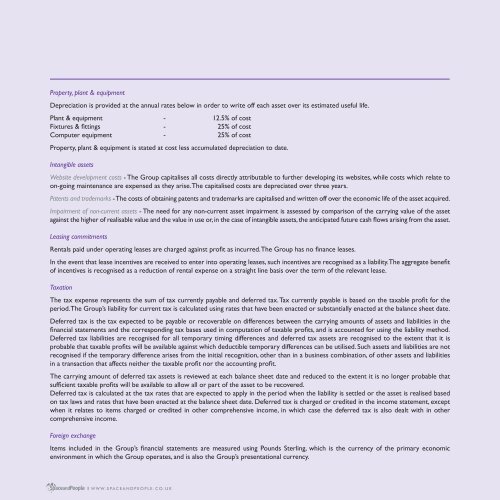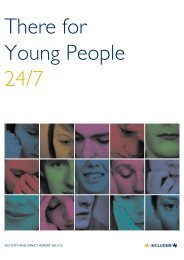S&P Annual Report for www
You also want an ePaper? Increase the reach of your titles
YUMPU automatically turns print PDFs into web optimized ePapers that Google loves.
48<br />
49<br />
Property, plant & equipment<br />
Depreciation is provided at the annual rates below in order to write off each asset over its estimated useful life.<br />
Plant & equipment - 12.5% of cost<br />
Fixtures & fittings - 25% of cost<br />
Computer equipment - 25% of cost<br />
Property, plant & equipment is stated at cost less accumulated depreciation to date.<br />
Intangible assets<br />
Website development costs - The Group capitalises all costs directly attributable to further developing its websites, while costs which relate to<br />
on-going maintenance are expensed as they arise. The capitalised costs are depreciated over three years.<br />
Patents and trademarks - The costs of obtaining patents and trademarks are capitalised and written off over the economic life of the asset acquired.<br />
Impairment of non-current assets - The need <strong>for</strong> any non-current asset impairment is assessed by comparison of the carrying value of the asset<br />
against the higher of realisable value and the value in use or, in the case of intangible assets, the anticipated future cash flows arising from the asset.<br />
Leasing commitments<br />
Rentals paid under operating leases are charged against profit as incurred. The Group has no finance leases.<br />
In the event that lease incentives are received to enter into operating leases, such incentives are recognised as a liability. The aggregate benefit<br />
of incentives is recognised as a reduction of rental expense on a straight line basis over the term of the relevant lease.<br />
Taxation<br />
The tax expense represents the sum of tax currently payable and deferred tax. Tax currently payable is based on the taxable profit <strong>for</strong> the<br />
period. The Group’s liability <strong>for</strong> current tax is calculated using rates that have been enacted or substantially enacted at the balance sheet date.<br />
Deferred tax is the tax expected to be payable or recoverable on differences between the carrying amounts of assets and liabilities in the<br />
financial statements and the corresponding tax bases used in computation of taxable profits, and is accounted <strong>for</strong> using the liability method.<br />
Deferred tax liabilities are recognised <strong>for</strong> all temporary timing differences and deferred tax assets are recognised to the extent that it is<br />
probable that taxable profits will be available against which deductible temporary differences can be utilised. Such assets and liabilities are not<br />
recognised if the temporary difference arises from the initial recognition, other than in a business combination, of other assets and liabilities<br />
in a transaction that affects neither the taxable profit nor the accounting profit.<br />
The carrying amount of deferred tax assets is reviewed at each balance sheet date and reduced to the extent it is no longer probable that<br />
sufficient taxable profits will be available to allow all or part of the asset to be recovered.<br />
Deferred tax is calculated at the tax rates that are expected to apply in the period when the liability is settled or the asset is realised based<br />
on tax laws and rates that have been enacted at the balance sheet date. Deferred tax is charged or credited in the income statement, except<br />
when it relates to items charged or credited in other comprehensive income, in which case the deferred tax is also dealt with in other<br />
comprehensive income.<br />
Foreign exchange<br />
Items included in the Group’s financial statements are measured using Pounds Sterling, which is the currency of the primary economic<br />
environment in which the Group operates, and is also the Group’s presentational currency.<br />
Transactions denominated in <strong>for</strong>eign currencies are translated into Sterling at the rates ruling at the dates of the transactions. Monetary assets<br />
and liabilities denominated in <strong>for</strong>eign currencies at the balance sheet date are translated at the rates at that date. These translation differences<br />
are dealt with in the profit and loss account.<br />
The income and expenditure of overseas operations are translated at the average rates of exchange during the period. Monetary items on the<br />
balance sheet are translated into Sterling at the rate of exchange ruling on the balance sheet date and fixed assets at historical rates. Exchange<br />
difference arising are treated as a movement in reserves.<br />
Financial instruments<br />
Financial assets and liabilities are recognised in the Group’s balance sheet when it becomes a party to the contractual provisions of the instrument.<br />
Trade and other receivables are carried at original invoice value less an allowance <strong>for</strong> any uncollectable amounts. An allowance <strong>for</strong> bad debts is<br />
made when there is objective evidence that the Group will not be able to collect the debts. Bad debts are written off in the income statement<br />
when identified.<br />
Cash and cash equivalents are carried in the balance sheet at cost and comprise cash in hand, cash at bank and deposits with banks.<br />
Trade and other payables are carried at amortised costs and represent liabilities <strong>for</strong> goods or services provided to the Group prior to the<br />
period end that are unpaid and arise when the Group becomes obliged to make future payments in respect of these goods and services.<br />
Equity instruments issued by the Group are recorded at the proceeds received, net of direct issue costs.<br />
Share based payments<br />
The Group operates a number of equity settled share based payment schemes under which share options are issued to certain employees.<br />
The fair value determined at the grant date of the equity settled share based payment, where material, is expensed on a straight line basis<br />
over the vesting period. For schemes with only market based per<strong>for</strong>mance conditions, those conditions are taken into account in arriving at<br />
the fair value at grant date.<br />
Pensions<br />
The Group pays contributions to the personal pension schemes of certain employees. Contributions are charged to the income statement in<br />
the period in which they fall due.<br />
Critical accounting judgements and estimates<br />
The preparation of financial statements in con<strong>for</strong>mity with IFRS requires the use of accounting estimates and assumptions that affect the<br />
reported amounts of assets and liabilities at the date of the financial statements and the reported amounts of income and expenditure during the<br />
period. Although these estimates are based on management’s best knowledge of current events and actions, actual results may differ from those<br />
estimates. IFRS also requires management to exercise its judgement in the process of applying the Group’s accounting policies.<br />
The areas where significant judgements and estimates have been made in the preparation of these financial statements are the useful lives and<br />
impairment of non-current and intangible assets, impairment of the value of investment in associates and taxation. Explanations of the methodology<br />
and the resultant assumptions are detailed in the relevant accounting policies above and the respective notes to the financial statements.<br />
Borrowing costs<br />
Borrowing costs are amortised over the duration of the loan and recognised throughout the term of the loan.<br />
WWW.SPACEANDPEOPLE.CO.UK<br />
ANNUAL REPORT AND ACCOUNTS 2014
















